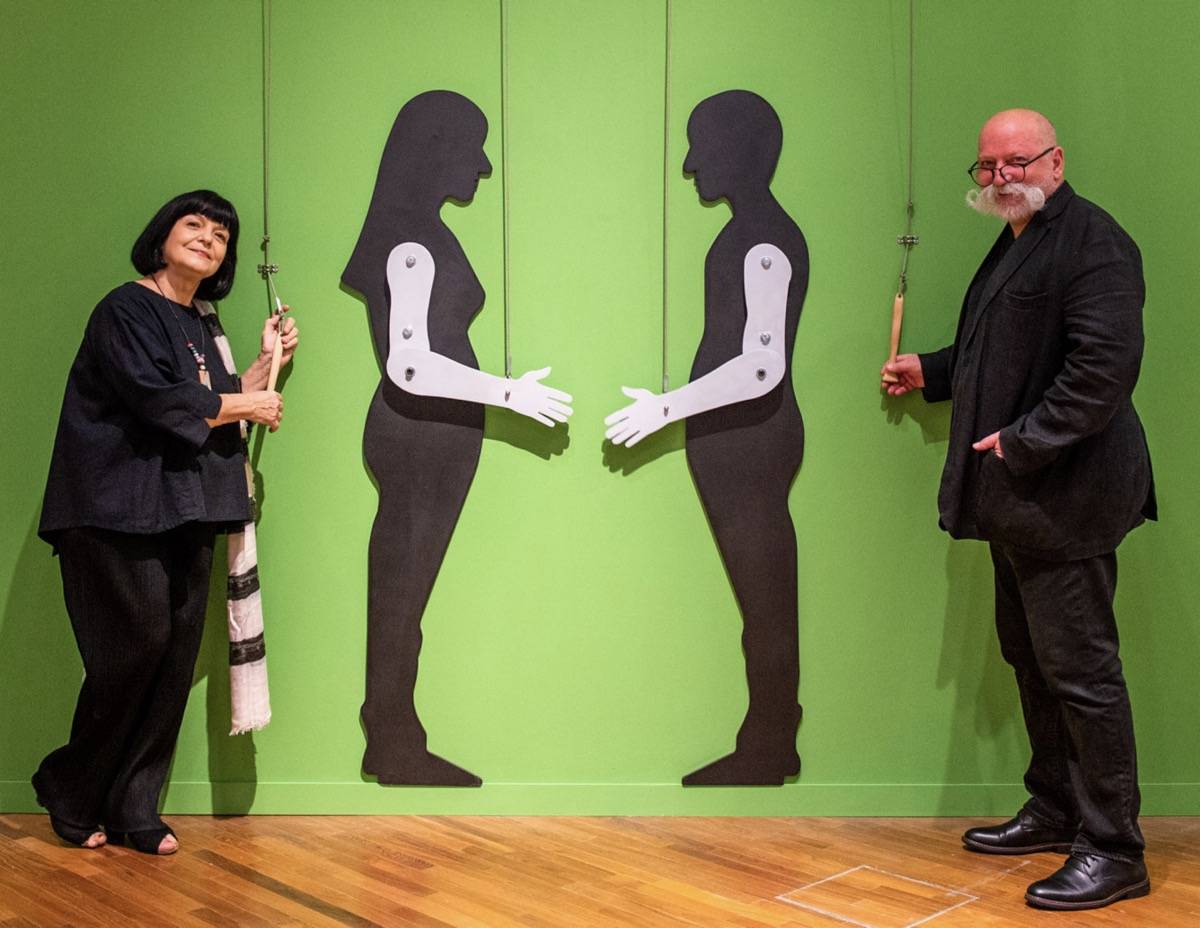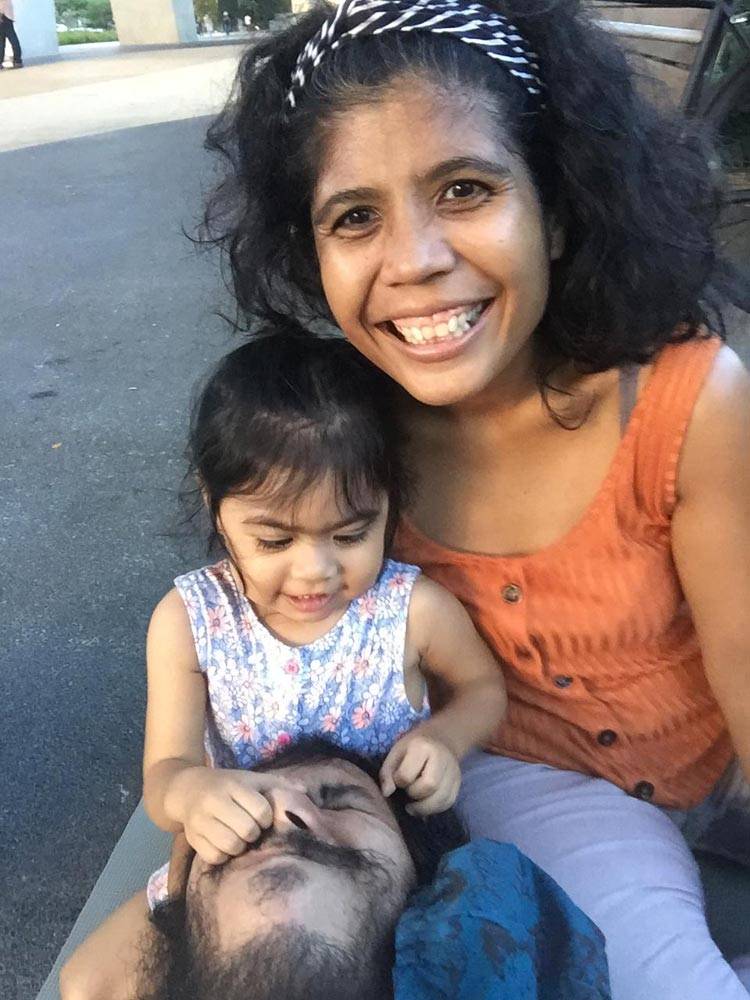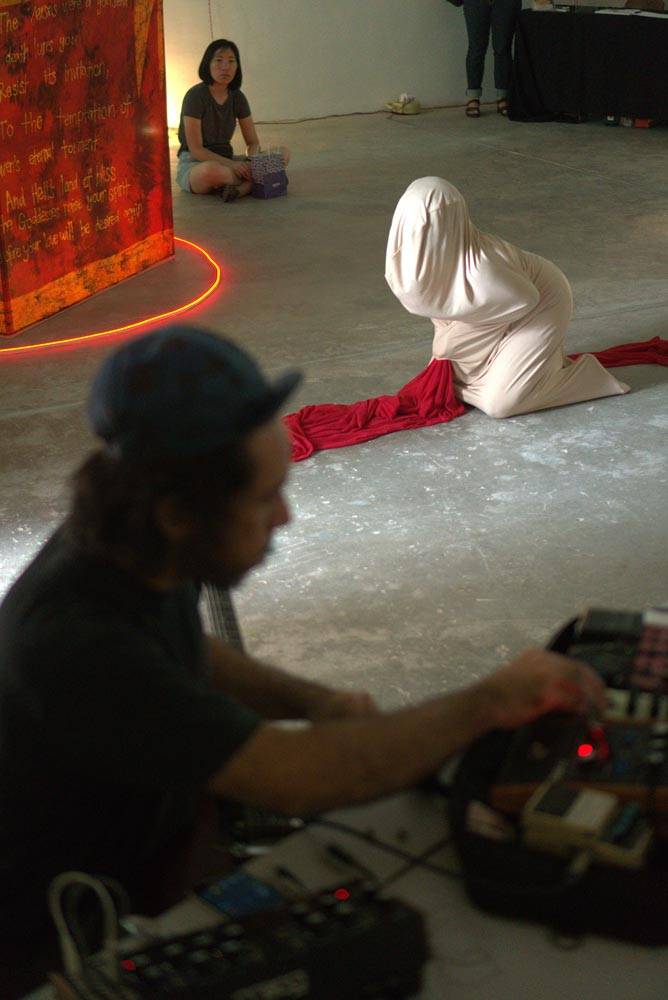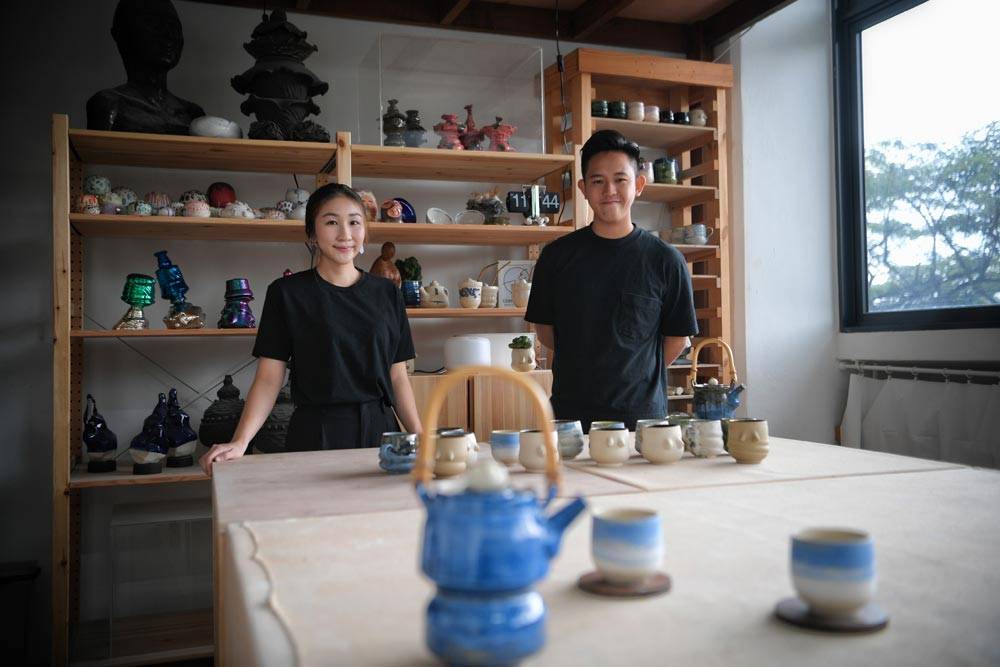It’s Valentine’s Day and love is in the air! We thought this would be a great opportunity to shine the spotlight on some of Singapore’s art world couples – what do creative couplings look like, and how might art affect love, or love affect art? We talk to five artist couples to find out.
Sojourning Sweethearts – Milenko and Delia Prvački

Veteran artists Milenko Prvački and his wife Delia Prvački née Iliesiu met as art students at the Institute of Fine Arts in Bucharest, in Delia’s native Romania. “Young, full of dreams and determined to live [their lives] fully”, they fell in love and eventually decided to marry. That was when they hit a roadblock – special permission from then-President Nicolae Ceaușescu’s State Council was required for Delia to marry Milenko, a “foreigner” from the former Yugoslavia. Permission was by no means guaranteed and the wait was an interminable 11 months.
Delia recounts the sweet story of the day they received permission to wed:
The day the postman delivered the letter, Milenko happened to be home, having just returned from a visit to his parents, back in Yugoslavia. He had brought a few bottles of Rakija [a potent traditional fruit brandy] with him and, by the time I arrived home from my classes, I found Milenko and the postman happily tipsy, “celebrating” the good news we had been impatiently waiting for. We got married in March 1975 and I left my country – for the first time and forever – in August 1975.
Settling into married life in what was then the Socialist Federal Republic of Yugoslavia, the artist duo at first maintained independent art practices – Delia in ceramics and Milenko in painting. The political situation in the country, however, was becoming more and more unstable, with increasing civil unrest. When Milenko accepted an invitation for what was supposed to be a short-term work stint in Singapore, they found it to be a hospitable place and, eventually, decided to make a home for themselves and their daughter Ana here.
It was in Singapore that Milenko and Delia began to make works collaboratively, even as they continued to develop and grow their individual art practices. “We realised that embarking on joint projects was very inspiring and stimulating for our individual practices. Traversing a trajectory that was challenging – getting familiarised to a new place, becoming Singaporeans – it was very helpful to be able to keep the art practice as a pivotal point between our distinctive personalities. It is an element that has kept us together for so many years, and one that generates a sense of accomplishment and fulfilment,” says Delia.
“Of course, there needs to be mutual recognition and respect for each other’s work … and a determination to protect and preserve the institution of marriage through all the challenges and difficulties we have met along the way, both as humans and as artists.”
“Our age, experience (and tolerance) help us very much,” adds Milenko!
Plant-whispering Paramours – Tini Aliman & Zarina Muhammad

Astute readers will note that sound designer and foley artist Tini Aliman’s name frequently appears in the production notes of artist, educator and writer-researcher Zarina Muhammad’s artist presentations, be it at NTU Centre for Contemporary Art (NTU CCA) or, most recently, at the Art Science Museum’s 2219: Futures Imagined.
It should thus come as no surprise, then, that the couple’s story began when they decided to meet up to discuss the possibilities of collaborating upon getting to know each other at a mutual friend’s performance art event. Who knew that that quick drink at Cider Pit would turn into co-habitation a mere three months later?
Though Tini and Zarina describe their respective research interests and practices as “quite diverging”, one area that intrigues them both is the field of plant ecologies and its cultural histories. Their research into plant consciousness and interspecies communication began in 2017, at their lecture performance at NTU CCA. On that occasion, they even brought a third party to their (collaborative) relationship: Ara, the banyan tree who lives in their backyard.
Since then, they’ve been listening to, talking with, and recording the sounds of plants, especially the ones that live with them. Between the plants and the myriad nonhuman beings that their practices involve, suffice to say that there’s never a dull moment in this creative partnership! As to the day-to-day, Zarina has this to say:
On good days, our production times are staggered but there are moments where we each simultaneously have ceaseless and relentless 16 hour days. At times like this we never fail to ask each other two questions at the end of the day: One – “How was your day?” Two, without waiting for the answer to the first question – “So, who will be cleaning Poopoo Land (cat litter for our three felines) tonight?”
Collegial Companions – Hazel Lim and Andreas Schlegel

Husband-and-wife artist duo Hazel Lim and Andreas Schlegel both teach at LASALLE College of the Arts, where Hazel leads the BA(Hons) Fine Arts programme, and Andreas lectures in Design Communication and heads the college’s interdisciplinary Media Lab. While they had previously seen each other around the college campus, Hazel recalls that they had never spoken to one another until they met and got better acquainted one evening at now-defunct underground music club Home Club, in September 2007. Sparks were then quickly ignited, and the rest is history!
Andreas and Hazel mostly work independently on their respective art practices, Andreas at the intersection of art and technology – creating audio, visual and physical outcomes driven by computation, interaction and networked processes – and Hazel often employing text, craft techniques and drawings to express her interest in the production of narratives, notions of displacement, and imaginary landscapes. However, they consider the fact that they are both artists a huge plus.
I think we admire each other’s approach to art making. It’s wonderful to have a partner who shares your love and passion for art, and it doesn’t hurt to have someone who understands your need to work on the weekend or till late at night, or your frustration when something doesn’t work out in a project, or your need to perfect an artwork. We spend a fair amount of our mealtimes talking about art and exhibitions we have seen. Visiting museums and viewing exhibitions is kinda the activity that we do together, especially when we travel with our Hanna [the couple’s seven-year-old daughter].
Given that their art practices are so distinctly different in medium, method, and areas of inquiry, we asked them what it was like when they collaborated for the first time, on their interactive art installation The Oort Cloud and the Blue Mountain for the Gallery Children’s Biennale in 2019. While admitting that it had been quite challenging due to moments where they couldn’t understand each other’s perspectives, they were able to weather those mini emotional crises together. ” It was a good experience, and now we know how we could work with each other. Yes, if an opportunity presents itself, we would definitely work together again,” says Hazel.
Chatroom Confidantes – Bani Haykal & ila

Raise your (probably non-millenial) hand if the term ‘IRC’ rings a bell in the recesses of your memory. That’s right, artist, composer and musician Bani Haykal and multi-disciplinary artist ila met back in 2005 when smart phones had yet to be invented, and chatting on the desktop computer with your friends via IRC was still the thing to do. (For the young amongst us, ila describes IRC as a sort of ‘Instagram equivalent’).
Back then, Bani was sharing his prose and poetry works online to anyone who was interested, and, as it turned out, ila was. Bani reflects, “I was quite surprised and appreciative of her taking time to read and respond to the works. She was (and still is) an extremely thoughtful and provocative individual who would challenge the texts. It was the most inspiring thing that could have ever happened online for me.”
During those days, their identities as artists had yet to coalesce, but ila is of the belief that “it was always the synergies, long late-night conversations, a shared Tumblr page, and years of play and experimentations that got us where we are today.”
Today, the couple are both practicing artists, and their partnership includes raising a three-year-old together and exploring collaborative performances. Their second and most recent artistic collaboration was at Pneuma, where they explored the idea of resilience via their respective mediums of performative movement (ila) and sound (Bani).
The couple share that their collaborative process is fairly fluid, and starts with a single prompt that they are both interested in responding to. For this particular work, the artists had discussed the sense of heaviness that memories can have, as if it were a thing that could attach itself to people, often even refusing to leave.

Of their performances, Bani says, “We respond to each other a lot, so sometimes even we stop thinking about who’s responding or who’s leading because it’s a role we both share.” Perhaps it’s a flow that comes naturally precisely because they have known each other so well, for so long. ila adds:
It’s a comforting feeling to be sharing a life with someone who is also practising art although most times it’s super intense. Being both artists, there’s never a mode where we are not picking at each other’s brains and working and the lines between the personal and professional are blurring into each other.
It’s not easy, and honestly there are days I think we wish for things to be easier, but it’s this synthesis process that keeps us constantly questioning and curious about the things we never knew which makes me feel that the difficulty is part of that process in learning and living together.
Business Baes – Fyon Cheong & Zestro Leow

To say that visual artists and educators Fyon Cheong and Zestro Leow are joined at the hip would not be much of an exaggeration. Zestro jokes that their relationship is even more intense than renowned performance artist Tehching Hsieh’s Rope Piece (the one where he spent a year joined to artist Lisa Montano by a 2.4m rope), because “at least the two didn’t start a business together”. The duo run Common Touch Craft Unit, a pottery studio which they co-founded. It is an enterprise that sees them spending 24 hours, 7 days a week with each other.
Fyon laughs, “These days, we spend so much time together that if we’re apart too long, we get separation anxiety. But because we are the only two people in our company, the many responsibilities that we each shoulder can be quite taxing. On top of that, pottery is a very labour-intensive business. We’re often physically tired and under stress – and that’s where our emotions can often get the better of us.”
Given that theirs is a two-person rig, it is all the more crucial that they are each other’s confidantes, cheerleaders, and when the occasion arises, sparring partners. Zestro candidly shares, “There are times when we have many disagreements, especially when we are brainstorming and settling business issues. But I see these conflicts as helpful to us, because it is in talking through our disagreements that we are able to better understand each other’s point of view, and in doing so evolve together.”
A year and a half since the birth of Common Touch, they’re still going strong. What keeps them together? Fyon credits the love that they have, not just for each other, but for their craft. After all, the couple’s first loves before they’d even met each other as students at the Nanyang Academy of Fine Art, was art.
“It was passion that started everything that we’ve created with each other. Without our love of our craft, we would not have created Common Touch. And to pull it through, to keep going it until now, takes our love for each other and the business that we’ve built together,” Fyon says with conviction in her voice.
___________________________________________
Feature Image: Anthony Poon RP6 – CR on 3P Waves (detail), 1991. Exhibited at Sundaram Tagore Singapore, in Transformation and Colour: Anthony Poon Pioneer of Singapore Abstraction, 27 May – 10 July 2016. Photograph by Pauline Gan.











